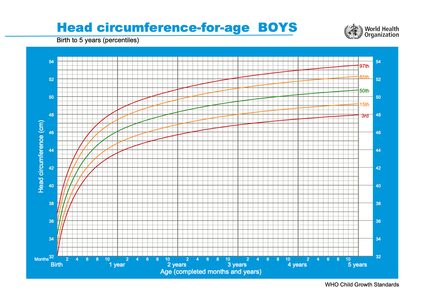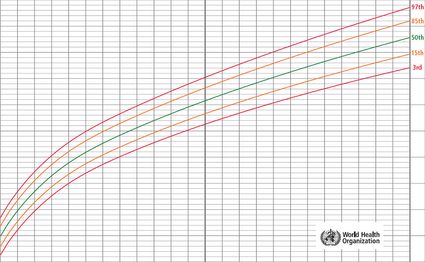Head Circumference Percentile Calculator
If you're interested in your child's growth, this head circumference percentile calculator will give you insight into your baby's development (for information immediately post-birth, check out the APGAR score calculator).
Take a look and see where your newborn's head circumference places amongst their peers. In the article below, we explain how to measure head circumference correctly, what child growth charts are, and how to interpret the results.
We try our best to make our Omni Calculators as precise and reliable as possible. However, this tool can never replace a professional doctor's assessment. All information on this website is for informational purposes only and is not intended to serve as a substitute for medical consultation. Always consult your results with a health care provider.
Why do we check a newborn head circumference?
A child's head circumference reflects the growth of their brain, and is therefore an indicator of the baby's development. The skull is the largest part of their body, with the average newborn’s head circumference measuring about 13.75 inches, or 35 cm if you prefer the metric system.
By the time a human is one month old, their head has grown to about 15 inches (38 cm). It has been observed that boys tend to be slightly taller than girls, but interestingly, the difference in newborn head circumference between sexes tends to be only around half an inch (1 cm). The height percentile calculator helps to assess differences between sexes in children.
The most important aspect of head circumference percentile charts is that they enable the doctor to monitor the child's growth. However, they are only partial information, and the patient has to be assessed as a whole.
It is acceptable when a child grows along similar percentile canal and the results from other measurement charts are consistent. Similar in the sense that there are no noticeable variations in the charts for height, weight, BMI, and head circumference. A child may be small and stay below 15th percentile all the time and be perfectly healthy at the same time. However, a difference of more than two canals should cause concern and require an urgent pediatrician consultation.
How to measure head circumference
There are some rules for measuring the size of a baby's head:
-
First of all, use a non-stretchable tape measure (most often a flexible metal or plastic). A piece of string will also do!
-
Wrap the tape from the most prominent part of the forehead — one finger above the eyebrows — then above the ears, and finally around the widest part of the back of the skull. Remember not to pull too tight. It should cover all the widest parts of the head, where the slope is most pronounced.
-
Remeasure — it is best to repeat the measurement three times.
Take the largest number and put this into the child growth calculator. Don't forget to select your baby's age and sex, and in the blink of an eye, you'll get an exact percentile your baby fits into, along with a graphic explaining where exactly your baby places.


How should I interpret the child growth calculator results?
Once you input all the information needed for the calculation, you'll see some numbers. These are your results. First — the exact percentile result. Just below that is the range in which the results are placed, e.g., between the 15th and 50th percentile.
Doctors consider the rate of growth as an important factor when looking at the child growth chart:
- On average, the child should follow a similar percentile canal on the chart as they grow.
- If the results cross two or more percentile lines (or they raise/decrease by at least two ranges), e.g., from 75th-85th to 15th-25th, you should consult a doctor.
Keep in mind that this tool can only be used if the child is less than 5 years old. Our data was derived from the WHO (World Health Organization), and the standards were developed using data collected by the WHO Multicentre Growth Reference Study, which only had data for kids up to that age. It is based on the simplified field tables for girls and boys. The calculations are estimated for the month of age and not detailed to weeks.

Head circumference percentile calculator in practice
To help you better understand how exactly this head circumference percentile calculator works, we have prepared an example. Our friend Stan has a daughter, the four months old Sophie. She was born perfectly on time, 40+0 week, and scored 9 out of 10 in the APGAR test. She's been in the 25th percentile since she was born in terms of head circumference.
Now, her head size is 39.8 cm; as mentioned, she is four months old and a girl. So, she is in the 28th percentile. What matters here is that she stays between the 25-50 percentiles.
Why do we use child growth charts?
This growth chart calculator gives you your results in percentiles. It is meant to compare your child's height, weight, BMI (estimated with BMI percentile calculator), and head size with that of their peers (of exactly the same age). They were developed using data from thousands of children, with their growth after monitored.
Each line (or percentile) on the growth chart shows how many children statistically have an exact head size at a specific age. As an example, the head circumference on the 25th percentile indicates that 75% of the children of that age have a larger head than that. Subsequently, one-fourth of the kids have a smaller head circumference than the given number.
Parents and pediatricians all over the world eagerly use percentile and child growth charts to follow children's development.
How do I calculate a baby's head circumference percentile?
To calculate the head circumference percentile of a baby, you will need to know:
- The age of the baby;
- The sex of the baby; and
- The circumference of their head.
The head circumference percentile is a measurement tool used to determine the size of a baby's head in relation to the general population of the same age and sex.
Place the head circumference on a chart to position the baby within the range of values of the population. For example, if 10% of babies have a larger head circumference, your baby is in the 90th percentile.
What does the 95th percentile mean for baby head?
It means the baby’s head circumference is larger than 95 percent of all other babies of the same age and sex.
Example: A 7-month-old baby girl with a head circumference of 17.72 inches is in the 95th percentile.
A healthy baby is considered to be between the 3rd and 97th percentiles.
What is the average size of a baby's head?
See the average size of a baby's head from birth to 24 months in the following table:
Baby's age | Head circumference | |
|---|---|---|
Girl | Boy | |
0 month old | 13.35 in | 13.58 in |
1 month old | 14.37 in | 14.69 in |
2 months old | 15.08 in | 15.39 in |
3 months old | 15.55 in | 15.95 in |
6 months old | 16.6 1in | 17.05 in |
9 months old | 17.24 in | 17.72 in |
12 months old | 17.68 in | 18.15 in |
15 months old | 17.99 in | 18.43 in |
18 months old | 18.19 in | 18.66 in |
21 months old | 18.39 in | 18.82 in |
24 months old | 18.58 in | 19.02 in |
A baby with an average head circumference is in the 50th percentile: 50% of babies their age have larger heads, and 50% have smaller ones.
Head circumference is systematically measured in infants up to 1 year of age.
What is macrocephaly in a baby?
Macrocephaly generally refers to an unusually large head circumference greater than the 97th percentile. Macrocephaly can result from several diseases or anomalies:
- Hydrocephalus;
- Subdural hematoma;
- Megalencephaly;
- Pericerebral effusions; or
- Metabolic disorders.
What is microcephaly in a baby?
A baby with microcephaly typically has a head circumference below the 3rd percentile, resulting in a smaller head than expected. A distinction is made between primary or congenital microcephaly, detected in utero before or at birth, and secondary or post-natal microcephaly, which may appear in the first few years of life.
There are many causes of early microcephaly in infants. The origin may be:
- Infectious;
- Vascular;
- Chromosomal;
- Toxic; or
- Genetic.